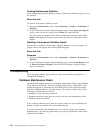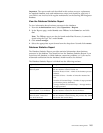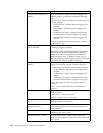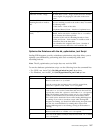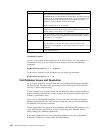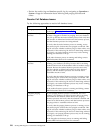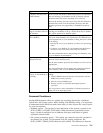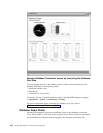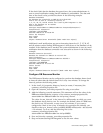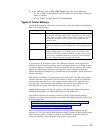content of the BLOB data is not the payload, but a serialized Java HashMap that
contains the file name of the payload. This is used to tie the file with the
document.
Use of the database or the system for persisting the document payload is specified
in the jdbc.properties file with the defaultDocumentStorageType property. This
setting is the system default and can be inherited or overridden at the WFD
(workflow definition) level. The location of document payloads is also configurable
in the jdbc.properties file with the document_dir property.
Database Connection Issues
You may find that your business process throughput slows down in Sterling B2B
Integrator during data bursts (sudden increase in data volumes) or connection or
cursor leaks (unreleased database connections). These can also result in an
increased number of failed pool requests.
Symptoms and Causes of Failed Database Connection Requests
The symptoms of an increasing number of failed pool requests may include:
v Slow business process throughput (volume being processed in a specific time
period).
v Increasing number of failed pool requests as seen in the Database Usage Report
by navigating to Operations > System > Troubleshooter. This report shows the
number of pool requests and failed requests.
Determining the cause of an increasing number of failed pool requests necessitates
you to investigate many areas of the system and the way in which you are
implementing Sterling B2B Integrator. The causes of an increasing number of failed
pool requests may include:
v Increased data volume, causing more business processes to compete for the
connections.
v Data bursts – High rates of data in short transmission periods.
v Connection or cursor leaks – Database connections that are opened for a
business process and then kept open by that business process instead of being
released back to Sterling B2B Integrator for use by other business processes. This
leads to fewer available connections to the database.
v Improperly tuned performance properties – Fewer database pools configured
than is required by your processing volumes. For more information, refer to
“View and Restore Performance Configuration Settings” on page 121.
To determine the cause of failed database connection requests:
v Monitor the Database Usage report.
v Monitor database tools specific to your database. For more information about
this, refer to your database documentation.
Monitor the Database Usage Report
This report shows the number of failed requests for each pool type. You can use
this information to determine which pool settings to change in the Performance
Tuning Utility.
1. From the Administration menu, navigate to Operations > System >
Troubleshooter as shown in the following figure.
222 Sterling B2B Integrator: Performance Management



